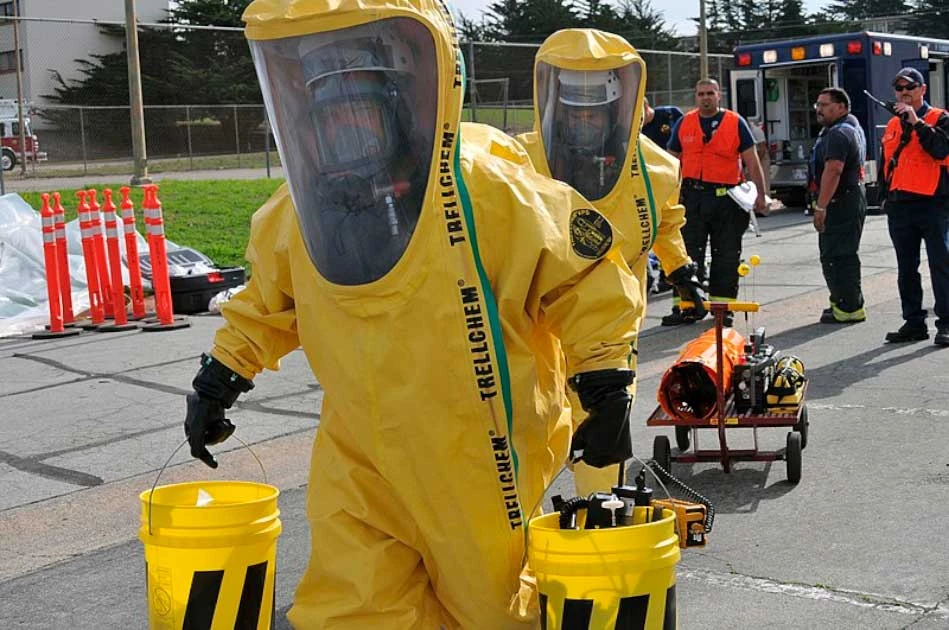When someone is described as a “toxic” person, the individual is considered poisonous, harmful, controlling, narcissistic, and prone to gaslighting those around them. But for one woman the term meant something much more literal.
Gloria Ramirez died in 1994, and at the time of her death was literally toxic. Something strange had been observed happening when doctors and nurses were trying to save Gloria Ramiez’s life. Staff started fainting, vomiting, convulsing, and having trouble breathing.
Something about Gloria Rameriz or something happening to her was releasing toxic gas, making people sick. While there are many possible theories about what happened in the ER on the last night of Rameriz’s life, the incident is still considered an unsolved mystery. What was happening to Gloria?
Gloria Ramirez
On February 19, 1994, at 8:15 pm, 31-year-old Gloria Ramirez arrived via ambulance at the Emergency Room at the Riverside General Hospital in Riverside, California. She was experiencing a rapid and irregular heartbeat and decreasing blood pressure, was almost incoherent, and was having trouble breathing.
Gloria Ramirez was already a very sick woman. She had been suffering from late-stage cervical cancer, and was dying.
Gloria Ramirez’s condition rapidly declined, and she needed to be defibrillated. That is when the medical staff began noticing strange things about their patient. When her shirt was removed, several ER staff saw Gloria Ramirez’s body was covered in what was described as an “oily sheen”.

Even stranger, the doctors and nurses could smell a “fruity garlic-like scent” coming from Gloria Ramirez’s mouth. Nurse Susan Kane, drawing Ramirez’s blood, noticed the blood had an ammonia-like smell.
This nurse later spoke about this and said she “thought it [blood] would smell like chemotherapy, the way the blood smells putrid when people are taking some of those drugs.” Kane passed the blood sample to the attending doctor, who agreed that the blood smelled like ammonia, before giving the vial to a medical student named Julie Gorchynski, who noticed strange manila-colored particles in the sample. This was the moment when things went from a bit odd to bizarre.
The Toxic Lady
After Kane handed the blood to Gorchynski, she fainted and was removed from the room. Gorchynski became nauseous and left the trauma bay to sit at the nurses’ desk; Julie fainted completely and had to be helped out.
When Gorchynski woke up soon after fainting, she began having symptoms normally unrelated to fainting. She experienced uncontrollable muscle spasms every few seconds, and apnea.
Apnea is the involuntary stop of breathing for multiple seconds before starting to breathe again. Back in the trauma room with Gloria Ramirez, a third nurse fainted too and reported she could not move her limbs when she awoke.
It then became apparent to the doctors and nurses that something was wrong when more nurses started feeling sick. They ordered all the patients in the ER to be evacuated to the parking lot to avoid contamination and the doors sealed.
That night, 23 of the 37 ER staff experienced symptoms, including a burning sensation on the face and trouble breathing, headache, nausea and vomiting, and uncontrollable tremors. A skeleton crew remained, trying to stabilize Gloria’s heart rate and breathing, but their efforts failed.
After being in the Riverside Emergency Room for 40 minutes, Gloria Ramirez was pronounced dead from kidney failure caused by her Stage 4 cervical cancer. However she was just as dangerous after her death as she had proven before, and a specialized hazmat team had to be called in just to move Gloria Ramirez’s body.

She was placed in a special hermetically sealed aluminum casket. A week later, at her autopsy, physicians also had to wear hazmat suits while working with her body. The press dubbed Gloria Ramirez “the Toxic Lady” or “the Toxic Woman,” and that is how she is remembered to this day.
The Aftermath
The death of Gloria Ramirez and the possibility of toxic fumes making ER staff sick started a massive forensic examination. Medical detectives from local, state, and federal agencies examined the hospital to determine the cause.
The hospital was searched for things like chemical leaks and if there was a way poisonous sewer gas was leaking into the ER. California’s Department of Health and Human Services sent two investigators to the hospital.
The investigators spoke with all of the staff in the ER who were working while Gloria Ramirez was in the trauma bay. They could not conclude how any of the symptoms could have been caused by toxic fumes. None of the patients in the ER got sick. Their conclusion? An episode of mass hysteria.
Mass hysteria, or mass psychogenic illness, is the spread of signs and symptoms of illness, but no infectious agent is causing the illness. The illness affects members of a cohesive group. While the causes of mass psychogenic illnesses are unclear, some can be caused by intense anxiety.
Common mass hysteria symptoms include headache, dizziness, nausea, and difficulty breathing (or hyperventilation). They also include vomiting, tingling/numbness/paralysis, and fainting.
Julie Gorchynski vehemently denied having been affected by mass hysteria. She “would have recognized it” and pointed to other issues she had that left her in the ICU as proof. She sued the hospital for $6 million in damages because she blamed the hospital for her extreme symptoms.
Mystery and Science
The coroner did three different autopsies over a period of time, and the results were described each time as “unremarkable”. Perplexed, the coroner’s office asked the Lawrence Livermore National Laboratory to help take a look at the case and see if they could find anything.
The case was examined by the lab’s Forensic Science Centre’s deputy director Patrick Grant, a nuclear chemist. The lab ran tissue and blood samples from Gloria Ramirez through a mass spectrometer to see what chemical compounds were in her system. This uncovered the presence of a mix of painkillers (likely for her end-stage cancer) and an unusual chemical known as Dimethyl sulfone.
Dimethyl sulfone, or DMSO, is sold in hardware stores as an intense degreaser but also was popular in the 1960s and 70s for muscle soreness. DMSO has been adopted as a home remedy for pain.
DMSO will not kill you. What it can do is leave your skin with an oily sheen that has a garlic-like smell. It also won’t make people around you start fainting and develop apnea, as the ER staff experienced. Even if Gloria Ramirez painted herself with DMSO cream or gel, it wouldn’t cause the strange symptoms experienced at the hospital.
- Hubert Chevis and the Poisoned Partridge
- Medical Malpractice and the Mysterious Death of George Washington
Dr. Grant did more research and discovered that DMSO gains one oxygen atom, it turns into dimethyl sulfone. However, if dimethyl sulfone gains two oxygen atoms, it reacts to form the chemical dimethyl sulfate.
Dimethyl Sulfate
Dimethyl sulfate, by contrast, is a nasty chemical; its vapors alone can kill cells in the eyes, mouth, and lungs. When the body absorbs dimethyl sulfate, it causes delayed damage to the heart, liver, and kidney, convulsions, coma, paralysis, and even death.

The vapors are harmful enough that dimethyl sulfate is classified as a “war gas.” The classified Department of Defense’s book, Reference Book on Chemical Warfare Information, had a report on dimethyl sulfate.
It was found that exposure to a tiny half a gram of dimethyl sulfate for ten minutes can kill people when it is dispersed in one cubic meter. Yeah, that is a nasty chemical. It has been tested to be used as a nerve gas, but it has never been manufactured for wartime use.
Dr. Grant and other scientists at the Livermore lab suggested that the DMSO in Gloria Rameriez’s bloodstream interacted with the oxygen and developed into dimethyl sulfate. The oxygen administered in the ambulance and ER led to a chemical reaction producing dimethyl sulfate.
Dimethyl sulfone converting into dimethyl sulfate is not something that is seen often. The results were compelling when the doctors’ and nurses’ symptoms were compared to the dimethyl sulfate exposure symptoms.
The ER staff mentioned the ammonium-like odor of her blood, before they started to experience fainting, apnea, shortness of breath, headaches, burning skin, nausea, and vomiting. Every symptom the ER staff had, matched the dimethyl sulfate exposure side effects. The Livermore lab published a report saying that this chemical reaction is likely the cause of the hospital staff’s symptoms.
This theory faced backlash from other scientists because there was no precedent for dimethyl sulfone reacting in a body with surplus oxygen and reacting to form dimethyl sulfate. The Livermore lab scientists pointed out that they did not definitively prove that this was what happened, only that it is likely the cause. It is worth noting that the Livermore lab’s explanation for the incident is appearing in science textbooks and is becoming accepted.
Other Theories?
Some other theories regarding the death of Gloria Ramirez, the Toxic Lady, are more dramatic than a chemical reaction. Ramirez’s family believes that the cause of death wasn’t related to her cancer. The incident is a coverup orchestrated by the Riverside General Hospital.

The family cites an incident where a toxic gas leak occurred at the same hospital caused by a damaged piece of equipment. The Ramirez family also cited an incident when toxic sewer gas leaked into the hospital. However, the leak was sealed, and the hospital was cleared to operate again.
It must be remembered that the Ramirez family was mourning the loss of a daughter, mother, and wife, and at the same time having to deal with the apparent news that Gloria was toxic and harmed other people as she lay dying on a gurney. Sometimes grief is so powerful that it makes you believe in things like coverups by a hospital.
Last but not least, everyone’s favorite theory: ALIENS! This theory is that the weird symptoms and the strange particles in Ramirez’s blood are solid proof of alien abduction. Believe what you want because a definitive explanation for the death of Gloria Rameriez has yet to surface. Her death and the incident in the ER might remain unsolved forever.
Top Image: The body of Gloria Ramirez was considered so toxic that the hospital was evacuated. Source: PHOTOLIFESTYLE / Adobe Stock.